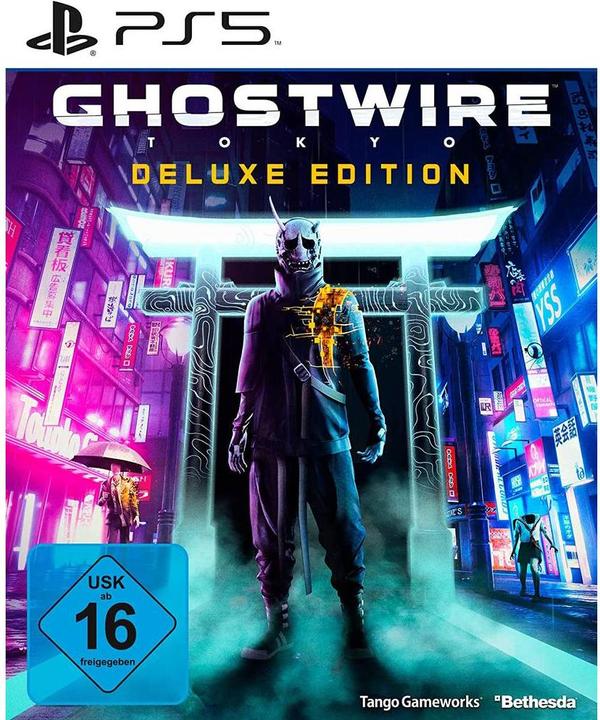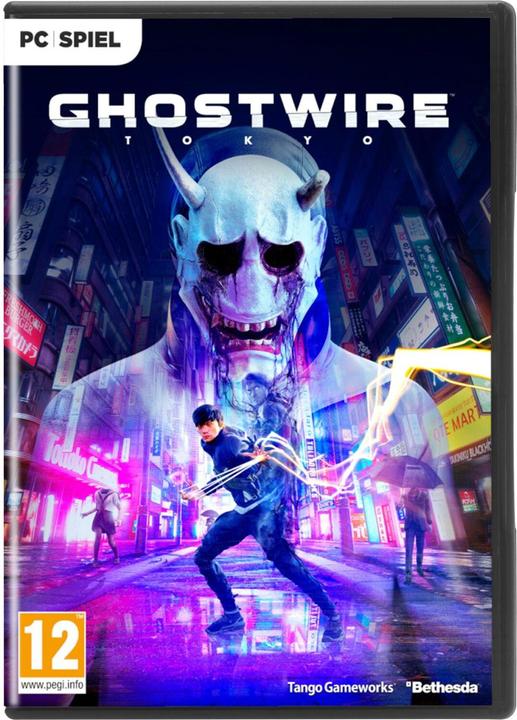

Ghostwire Tokyo in test: Creative shell, conventional core
What is Ghostwire Tokyo, anyway? Since the announcement of the new game from Tango Gameworks, the title has been a mystery for many gamers. Now that we have played through Ghostwire Tokyo, we can reveal the secret, but the answer might be unsatisfactory for many players. Find out why in the review with video!
This is an article from our content partner "PC Games ". Here you can find the original article by author Stefan Wilhelm.
Almost five years after The Evil Within 2, Shinji Mikami and Tango Gameworks enter the stage with a new game and throw almost everything you know the young studio with the old developers for over the pile. After two survival horror outings, Ghostwire Tokyo takes you on an open-world trip through the deserted streets of the city and lets you exorcise a lot of ghosts in action-packed shooter battles. In the review, we'll tell you how an actually unused scenario turns into routine remarkably quickly and why Ghostwire Tokyo has become a solid, but never really inspiring adventure.
Despite the new gameplay direction, Tango once again opens its new game with a mysterious, gloomy setting: a dense fog has turned Tokyo into a ghost town, 99 percent of the population has disappeared without a trace. The advertisements are still flashing, the radios are blaring, and the streets are littered with the clothes of pedestrians, as if they had all literally jumped out of their skins in a split second.
You slip into the role of Akito, who was just about to visit his hospitalized sister and now suddenly finds himself in this surreal world. Fortunately, Shiba Inus and cats have been spared!
One Night in Tokyo
You can clearly feel that the development team is based here when roaming the atmospherically lit streets, because Ghostwire's game world conveys a great feeling of Tokyo. The contrast of cutting-edge, neon-soaked pop culture and ancient mythology has been captured with great attention to detail, and the city feels alive, even if it literally isn't.

After all, since the Fog Flood, only the dead dance through the streets here. The "visitors" come in the form of pale businessmen, headless schoolgirls and oversized women in raincoats, for example, and are the main antagonists in the game.
Here, as in its previous titles, Tango once again scores with wonderfully eerie enemy design, although Ghostwire Tokyo has no ambitions to scare you. Instead of forcing you to run and hide or relying on jumpscares and splatter, the game makes your protagonist a defensible fighter right from the start.
Akito merges with the soul of KK, a professional ghost hunter who gets inside your head in search of his teammates and puts magical abilities at your disposal.
Kameeeehameeeaaaa!
The two of them are the only characters you'll get to know in more detail in the game, as both KK's former team and the antagonists led by the masked Hannya remain comparatively pale.

Because you also only talk to the former inhabitants of Tokyo in the context of short side quests, Akito and KK carry most of the narrative load. Fortunately, they do a good job: The relationship between the two unfolds as a likeable, if not really new, buddy story that remains pleasantly down-to-earth despite the setting.
This is also ensured by the successful German dubbing, where Tommy Morgenstern as Akito is particularly convincing. For maximum immersion, Ghostwire also provides the original Japanese audio.
New shell, old core
The game world is already immersive and pretty, but what do you do in the extinct city? Well, because Ghostwire Tokyo is strongly oriented towards classic western open-world design á la Ubisoft, you mainly liberate outposts in the form of Torii gates and thus uncover symbols on the map, which you can then freely rummage through.
Unlike many of its genre colleagues, however, the game prevents you from exploring a map area until you have cleared it of the deadly fog.
After that, you'll find plenty of collectibles that you can turn into money, the aforementioned side missions, as well as all sorts of means to fill out your character's skill screen.
The design of the side quests is functional, but doesn't win any innovation prizes: sometimes you have to stop a horde of visitors from capturing lost souls, occasionally you'll run after a Yokai or drive it out of its hiding place, and you'll give dog food to the Shiba Inus scattered all over the place so that they'll track down buried money for you - after you've petted them, of course.
Ghost stories
More interesting are the several tasks you complete for the ghosts of the townspeople. Here you are often presented with entertaining and interesting mini-stories: For example, you'll deliver toilet paper to a ghost stuck on the toilet, so that he can finally wipe his butt and find peace of mind. Another Tokyo resident will tell you about a secret subway station that is only visited by a completely empty train.
And for an elderly ghost lady, you'll free a lucky yokai from the clutches of her greedy landlord. However, most of these quests are completed in under five minutes, so you shouldn't expect much depth from the stories and dialogs. And this is a problem that runs through large parts of the game: Ghostwire Tokyo starts off with interesting ideas, but then often settles for the lowest average when it comes to implementation.

This is most noticeable in the combat and progression system. In main and side quests, as well as while exploring, you'll constantly be involved in battles with the visitors, whom you'll confront with KK's magical abilities. Once you've shot sufficiently large holes in the grotesque monsters' bodies, you'll snatch their cores with fancy animations to replenish your ammo.
The basic building blocks for fun and challenging battles are actually in place: Sending a projectile back to the sender with a parry or finishing off several enemies at once thanks to an area attack feels really good, especially thanks to the gaudy audiovisual effects.
We also want to praise the Dualsense support, which not only PS5, but also PC players can enjoy: The spells and takedowns have different resistances in the triggers, the haptic feedback is fine and precise, and when you collect coins, you can not only hear the jingling, but almost feel it through delicate engine movements.
Moderately charming
Unfortunately, though, the developers have failed to give the combat system even a hint of the depth it actually deserves, given its core design. Although the game's focus on magic opens up virtually all doors and possibilities, you're fobbed off with a paltry three (!) spells and a bow, whose tactical potential you'll have exhausted after just a few fights.
Effectively, the spells only fulfill the roles of a pistol, a sword and a rocket launcher, which you can at least charge for more damage and a larger explosion radius. Creative and versatile looks different, though. Damage and radius then are the only things that matter in the battles, since the enemies don't have any particular weak points to exploit with certain attacks. Some of them only carry umbrellas, which you'll have to shoot past. If you want, you'll still be able to sneak to eliminate enemies silently with a bow or a melee takedown from behind.
You can also use a handful of consumable talismans to make a lightning field or a bush appear for hiding, which is nice, but hardly necessary. Finally, in very few places you'll be confronted with boss enemies, but they don't require any approach other than bouncing you over a shockwave every now and then. And that's it. Especially with a combat designer on board who was also involved in the Doom reboot, there should have been a lot more here.

Progress skeleton
The character progression is also rather unspectacular: You level up with captured ghosts and completed missions and buy simple upgrades. These provide you with a larger quiver for the bow, a higher explosion radius for the fire spell, or faster executions in several stages.
All of this works and motivates to a certain degree, but even with its progression system, the game is content with the bare minimum. The same goes for the marginal buffs you get from food and the few unlockable clothes you only get to see in cutscenes and in photo mode.
Now, it would be unfair to claim that Ghostwire Tokyo would only bore you after the interesting first hours. Exploring the atmospheric, elaborately designed game world is fun until the end, because the developers give you cool movement tools with grappling hooks and hovering abilities and trust you to find your own ways to the often well-hidden targets.
The story doesn't pull any trees out of the ground and is relatively short with about ten hours, but it is still entertaining and manages to hit a few emotional notes towards the end. And because the enemies deal out decent damage and the combat system basically works properly, the battles never completely become a no-brainer.
Ultimately, though, it's still just a shame how little Ghostwire Tokyo makes of its setting, how little it goes into depth with its stories and gameplay systems, and how cranked down the whole thing often feels.
You're not completely sick of this kind of game yet and you're excited about the successfully captured Japan feeling? Then you can spend a few shallow but entertaining hours with Ghostwire Tokyo. For the rest of us, however, this is just another world map littered with symbols, where only the setting stands out from its genre colleagues.
Conclusion: Interesting setting, but routine sets in far too quickly.
Ghostwire Tokyo actually has all the prerequisites to break out of the western open-world format, which has become rather tired in the meantime: Tokyo as a setting has been captured great, the main and side quests have interesting, fresh premises and the battles are pleasantly reminiscent of skill-based arcade shooters at first. However, the game settles for far too little in almost all aspects. The game world is filled with irrelevant collectible stuff, the quests are far too short and superficial to even exploit their premises, and the weapon and enemy variety leaves more than enough to be desired. Still, I had my fun: The battles work despite their lack of depth, exploring is entertaining thanks to the high verticality of the game world, and visually the game is appealing because of loving details, such as when I noticed that the raindrops are made of characters. However, because the substructure behind the creative design is rather shallow and generic, the game is only rated "quite alright".
Ghostwire Tokyo will be released exclusively for Playstation 5 and PC on March 25, 2022. An Xbox version should be released in about a year, once the exclusivity period is over. Are you looking forward to the horror adventure or do you find the setting rather uninteresting? Tell us in the comments!
Pro
- Beautifully designed city with many loving details
- Great Tokyo feelingSympathetic main characters with good German dubbing
- Movement and exploration entertaining
- Many funny story ideas for side quests
- Successful Dualsense integration
- In essence, fun, challenging battles ...
Contra
- ... which lack a lot of depth and variety
- Trivial progression mechanics
- Side missions far too short and simple
- Repetitive gameplay that quickly becomes routine
- Relatively short gameplay time
- Plate antagonists and side characters
PC games: cutting-edge news, videos, previews and critical reviews, thoroughly researched reports and handy tips on everything to do with PC games, console games and PC hardware.




